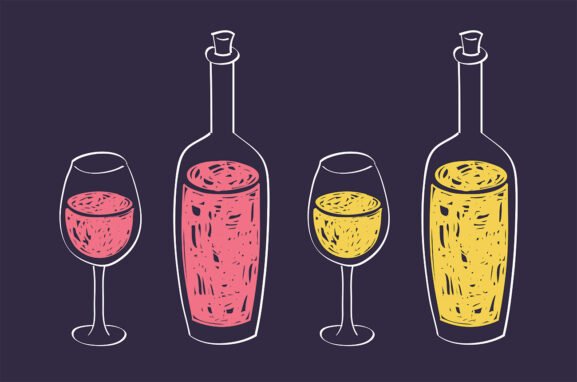Are Expensive Wine Glasses Worth It?
The puckish 2020 book How to Drink Wine: The Easiest Way to Learn What You Like declares what amounts to fighting words in some circles: “All you need is one all-purpose wine glass.” Co-authors Grant Reynolds, the sommelier and founder of the Dimes Square wine shop Parcelle, and Chris Stang, the founder of The Infatuation, take a highly democratic approach to sipping, going further with the dictum: “If you want a Champagne flute, too, go ahead and get one. But the only difference between drinking Champagne from a flute and Champagne from an all-purpose glass is how fancy you feel when you’re holding it.” They also note that all you really need is a cheap wine key—sorry, Rabbit—and that if you like Pinot Grigio that’s probably because it reminds you of water.
A Champagne flute—or coupe—might be the most famous of wine-specific glassware, but there’s an array of design details that claim to spotlight elements of whatever you’re drinking. A glass’s proportions are essential, especially the shape of the bowl, the height of the stem, the sharpness of a rim and the material it’s made from. And they’re priced accordingly, from five-dollar stemware at Crate & Barrel to a $420 pair of Baccarat Grand Burgundy glasses and a $4,500 crystal goblet from Lobmeyr.
Though you can certainly buy all kinds of glasses from high-end makers like Riedel and Zalto, or comparatively more affordable options like Wine Enthusiast’s Pirouette and Aria stemware, the fact that many brands offer a universal glass suggests that, at some level, the industry agrees that one is all you really need. So if one is enough, how much should it cost? And more importantly, how strongly does the price of a wine glass correspond to the experience of drinking from it?
I turned to Jonah Beer, Principal and CEO of Gabriel-Glas North America, an Austrian stemware brand founded by the noted Swiss wine critic René Gabriel, to ask if drinking from a $100 wine glass is really all that much better than drinking from a well-made glass for, say, $30. He was as blunt as Reynolds and Stang. “No, there’s not much difference,” Beer told me.
In the shop
Riedel Winewings 4-Piece Tasting Collection
In Stock | $200
Beer likened the experience of drinking from wine glasses to drinking wine itself. “The difference between a three-dollar bottle of grocery store wine and a $30 bottle from a small vineyard and winery is truly a ten-fold or even 100-fold improvement in quality and flavor,” he says. “But from a $500 bottle to $1,000 bottle, you’re paying for scarcity and rarity.”
You’re also, perhaps, paying for a kind of insider prestige. Beer worries that in promising wine lovers a chance to wrest every note from every varietal, the glassware market has ballooned to comic proportions.
“What we often see with the over-fetishization of wine glasses is a cupboard filled with every size and shape,” he says. “Some people have 30 glasses for Chardonnay and there’s a point where you have to call bullshit on that.”
Gabriel-Glas offers just one universal, stemmed wine glass—either machine-blown for $34 each, or mouth-blown for $99. The difference in manufacturing, and thus price, between his two glasses is not at all about function and entirely about an aesthetic experience. “There’s a point where it’s become design for design’s sake and that’s what we’re pushing back against,” Beer adds. “The $100 glass does not improve the wine sensation. It’s a glass you buy because of how it makes you feel. When you hold something artisan crafted, handmade, nothing industrial about it—it’s different.”
You May Also Like: The Difference Between Red and White Wine Glasses
Beer recommends that you look at a glass’s design and construction over its price. Whether machine or man-made, a quality glass has, in his eyes, a few hallmarks.
First is materials. He looks for crystal (not glass), which is finer, more durable, and delivers better clarity, allowing wine lovers to appreciate the beauty and movement of the wine in the glass. He also insists on a thin, durable crystal, with a razor-sharp lip. This prevents wine from splashing into your mouth, instead allowing it to cascade onto the palate.
The size of the glass’s aperture is also important so you can get your nose inside, but must remain proportional to the width of the bowl. “That’s what either promotes or demures the bouquet and aromas,” he explains.
These details also define Wine Enthusiast’s Somm universal glass, which is handblown with a wide hourglass-shaped bowl and thin rim designed to enhance the aromas in what you’re drinking. Anna-Christina Cabrales, Director of Tasting at Wine Enthusiast, prefers the Aria, which is hand-blown from crystal and has a long and narrow bowl for slower oxidation. Her team uses this glass for its blind tastings. “I found the Aria glass consistent in expressing various varietals and their respective regions,” Cabrales says.
Orenda and Peter Hale have owned and operated Maine & Loire, a natural wine shop in Portland, Maine, since 2015. They stick to one of two glasses, either the Stölzle Exquisit or the Stölzle INAO Tasting, $16 and $14 respectively.
“From day one, we’ve been trying to lower the stakes to get more people in the door and curious about natural wine,” Orenda says. “For us, the glassware goes along with that—keeping it accessible, finding the best thing we can that’s affordable.”
Maine & Loire sells the same glassware that Orenda and Peter use at home. The Stölzle glasses have a good size, V-shaped base of the bowl which allows in enough air for the wine to breathe. They’re also delicate enough to have some finesse, valuable but not precious.
“You drink out of a Zalto and, sure, it’s a different creature,” says Peter. “Thin crystal, the way the wine moves. There certainly are glasses designed to magnify aspects of wine like aromatics. But I don’t think it’s that much better. The Zalto maybe isn’t even yours, you’re in a restaurant with a high aesthetic level and there’s all this wonderful feeling around you. That’s because you’re in an elevated circumstance. Look, everything tastes better in France, and it’s not because of the glasses.”
You May Also Like: The Right Glassware for Every Drink
Shelley Lindgren is a sommelier, owner and wine director of the A16 restaurants in San Francisco and Oakland and author of the book Italian Wine. She’s all for varietal-specific glassware that spotlight a wine’s unique qualities. She uses nine different wine glasses in her restaurants, but knows all too well that when running a business, a closet full of Josephines—Kurt-Josef Zalto’s new brand—is a luxury even her wine-forward A16 locations can ill afford.
For the most part, A16 uses Riedel Restaurant Extreme glasses. “We opened with them 20 years ago, and though there are more options on the market today, Riedel has done a great job with the science of wine tasting,” Lindgren says. “They deliver, but it’s also not going to break the bank if it breaks. Though, boy, would it be great if we had less breakage.”
As wine lovers who came up through the restaurant world, the Hales echo Lindgren’s breaking point and again call out their beloved Stölzles for sitting at a price where nobody sheds a tear if one hits the back patio.
“As a lifelong bartender, the most important thing in my mind is that a wine glass is clean,” says Peter. “That supersedes any design element. Clean and well polished, no soap, no wet from the rag. I mean clean clean.”

In the shop
Zalto Denk’Art Universal Glass Set of 6
In Stock | $469
Published: May 30, 2024

